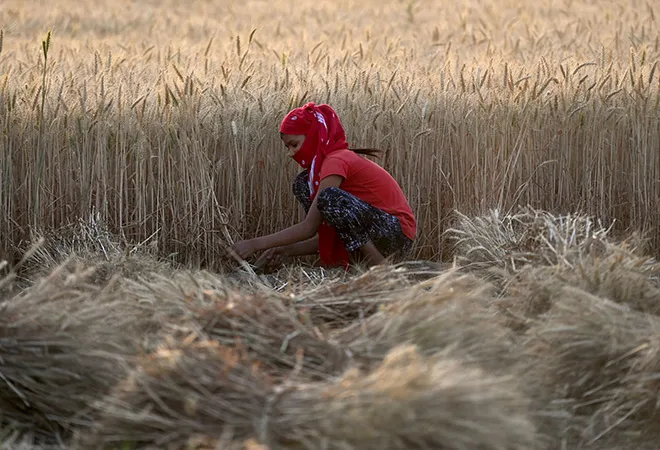
Why should we regard it as girl capital?
Much remorse had already been expended on the gender gaps in society and the pandemic cruelly exposed the fault lines. However, the time for appealing to compassion or pleading for charity is over as this has simply not resulted in change as fast or as much as is needed. In the same way that a green recovery from COVID is increasingly viewed as necessary alongside livelihoods creation with big economic multipliers, it is time we realise that a gendered recovery also represents one of the most potent levers in our post-pandemic toolkit.
Girls and young women who are reasonably educated and adequately skilled (with both technical skills as well as life skills) have the opportunity earn an income, which transform their voice and influence at home and in society. They are able to take decisions on marriage, motherhood, family finances as well as their children's futures. All these will contribute to a better
and more sustainable world.
Investing in girls and young women will deliver big, long, and wide returns for the whole of society. They represent a much-ignored, high-grade investment. This shift of looking at girls and women as assets rather than liabilities lays the ground for investing—as one does—in assets. Natural capital and human capital sit side-by-side as the growth stories of this century.
Women as the bulwark of resilience for future shocks
Pandemics and disasters will, unfortunately, be more frequent and more severe in the context of a changing climate. While the world must do everything it can to prevent and better manage these threats, the socio-economic meltdown that ensued most certainly does not need to be repeated. A key solution will be to build the economic and social resilience of communities and nations. One path to climate and pandemic resilience starts with women.
When women work, economies grow and nations advance. Women’s economic empowerment boosts
economic diversification and income equality.
Gender gaps drag down the global economy by as much
15 percent of GDP. If women worked as much as men in India, GDP would grow by an additional 1.4 percent. We know, that despite gender inequalities, women migrant workers sent
half of the US $600 billion in global remittances in 2016.
When women work and lead, companies perform better. Shareholder value creation and organisational effectiveness both
increase with more women as employees and leaders.
The desperately low levels of girls’ education and skilling as well as female labour force participation must be corrected as these are critical components of sturdier and more self-sufficient societies.
- How do we ensure prioritising and investing in education, skills development, and female labour force participation?
- How does fair wages, safe workplaces, and maternity benefits become the accepted, normal way of doing things in India. Is there a role for affirmative action?
- How do we promote corporates to employ more women and inspire them to have more women in leadership roles?
- What is the need and potential to foster coalitions and build movements like the recently launched Generation Equality campaign, and how do we encourage broader collaboration?
Education is the silver bullet for a lasting recovery
While one is tempted to look at development and suggest there are no silver bullets, the evidence behind girls’ education is compelling enough to suggest it might well be as close to one as we will ever get.
Educating girls is amongst the most effective solutions that can contribute to limiting global warming to 1.5
°C<1>. This is because of more independent decision-making on motherhood<2>, correlations between female decision making and environmental responsibility<3> as well as helping girls participate in emerging green jobs<4>. It is estimated that increased female educational attainment accounts for nearly half of all economic growth in Organisation for Economic Co-operation and Development (OECD) countries
over the past 50 years. The ability of children to reach their full potential is significantly determined by the health, nutritional, and educational status of their mothers
<5><6><7><8>. Of these, the educational status is the leading indicator.
- How do we reduce the time, cost, lack of safety, and inconvenience of going to schools (particularly secondary)?
- What role can targeted cash transfers play in some of these? Is there an argument for extending Right to Education (RTE) to secondary school?
- How do we create a social revolution that upturns deeply entrenched patriarchy?
- How do we embed life skills education such that girls are equipped to realise potential in a rapidly changing world?
- How do we generate and fulfil demand for new contraceptive choices?
This new world we are in has new opportunities for sustainable, inclusive development—with women at the vanguard
The pandemic has opened up new areas of livelihoods creation as business models have been upturned—from last-mile e-commerce delivery to rural financial products selling. Female entrepreneurship can fuel a lot of this growth but is held back by poor access to capital, skills, confidence, and enabling environments.
Promoting green entrepreneurship models for women in rural areas (such as water conservation or low-carbon agriculture or last-mile renewables) provide the perfect confluence of environment, inclusive development, and social norm change.
- How do we improve access to capital to female entrepreneurs?
- How do we create models of mentorship and community building for them?
- What policy changes or incentive structures will be needed to improve market linkages and moving up the value chain for them?
- How does “Made by an Indian Woman” become a competitive lever?
Redressing structural flaws that hold back progress
There have been tough barriers that girls and women face, which have been aggravated by the pandemic and must be addressed deliberately in recovery planning. The gender digital divide is real and severe. This is ingrained by financial and cultural causes. Unless we are able to bridge it, digital education and financial inclusion will be effective for only half the country.
Unpaid care work has been a burden hidden from public view. Women in employment found themselves doing three jobs—child and household care, teacher and their ostensible day jobs. Those outside the formal sector have had to curtail or stop entirely their economic activity.
One aspect that holds back women from work is the absence of affordable, safe childcare, adequate leave entitlements and flexible working hours. Women drop out of the work force or do not return back as fast as they might want to due to this. Trends like migration and nuclear families will only increase this. Elder girl siblings are forced to drop out of school to look after younger ones.
- What do we do so girls are not left behind digitally? How do we normalise girls having access to mobile phones or computer screens? How do we foster online communities where girls can find comradeship and support?
- How do we address unpaid care? Is compensating for it part of a viable solution to drive the social change necessary to acknowledge and value it?
- What will it take for the government to treat childcare as an essential service and for business to know it as a basic employment right, even in the unemployed sector? Are there legal and policy interventions to drive this?
Forcing the system to think and act gender-just
A stark reminder of the gender gap of our age has been the inadequate gender splits of data. It is surprisingly hard to get answers for a simple question like how many women have got the COVID-19 vaccines. Everyone—from governments to development organisations to corporates—must gather, report, and act on gender data.
This absence of gender disaggregated data is worrying but is a mere symptom. We need to both have and hear the voices girls and women. This is particularly needed in social protection, financial inclusion, and digital access. Where it is present, it has huge potential—
like the benefits for women from MNREGA—in incomes and empowerment, even if it was not part of the original vision and thinking.
Putting money directly in the hands of women—in the form cash transfers for household expenses, or capital for working capital or asset creation—has a huge body of evidence that establishes supernormal returns for it.
- How do we translate the—very real—economic, political, and business asset that women represent into hard action?
- How do women’s issues become human rights, political imperative, and business drivers?
- How does the instinctive starting point at a Board meeting, or a NITI Aayog recommendation, or a civil society gathering, or a political campaign brainstorm, or a judicial judgement become, “What does it mean for women?”
In conclusion, the pandemic has hit women hardest; let us avoid the recovery doing the same —as it will not just be women who will pay the price for it
As we rebuild better, we need to rebuild together. This isn’t just a moral issue but a pragmatic issue; investing in girls and women has returns not just for them, but for everyone. An educated, skilled, and economically productive woman has more authority and ability to influence decisions on health, nutrition, and education for the whole family.
Taking India’s female labour force participation up from the current ~20 percent level will provide amongst the largest and most sustained boosts to GDP from the entire suite of possible priorities.Empowering women in the economy and closing gender gaps in the world of work are essential to achieving the Sustainable Development Goals, directly for Goal 5 (gender equality), and Goal 8 (employment), and indirectly, but substantively, on Goal 1 (ending poverty), Goal 2 (food security), Goal 3 (health), and Goal 10 (reducing inequalities).
Ideas like the Green New Deal are premised on—amongst other things—redressing historical injustices and creating sustainable platforms for humanity’s progress; concepts like employment, justice for women, and fostering equal opportunities for them are integral to the solutions for this (or indeed similar movements).
The recovery that we all should seek is one that is inherently more inclusive and sustainable. Inclusiveness has to address gender. A world that discriminates half the population will never realise its fullest potential. Sustainability will come from effective government activity, viable business models, environmental responsibility, and societal sanction. This sanction will come when women are welcomed aboard.
Investing in girls and women is the force multiplier we so fervently aspire to, and so urgently need.
<1> Kwauk & Braga 2017; Lutz et al. 2014; Muttarak & Lutz 2014; Muttarak & Pothisiri 2013
<2> Atkinson & Bruce 2015; Potts & Graves 2013; UNFPA 2017
<3> Lv & Deng 2019; Mavisakalyan & Tarverdi 2018
<4> Kwauk & Braga 2017; Muttarak & Striessnig 2014; UNDP 2012
<5> UNESCO. 2014c. Teaching and Learning: Achieving Quality for All—EFA Global Monitoring Report 2013/4. Paris: UNESCO.
<6> UNIGME. 2014. Levels and Trends in Child Mortality Report 2014: Estimates Developed by the UNIGME. New York: UNICEF.
<7> Black, R. E., L. H. Allen, Z. A. Bhutta, L. E. Caulfield, M. De Onis, M. Ezzati, C. Mathers, and J. Rivera. 2008. “Maternal and Child Undernutrition: Global and Regional Exposures and Health Consequences.” The Lancet 371, no. 9608:
<8> Klugman, Jeni, et al. 2014. Voice and Agency: Empowering Women and Girls for Shared Prosperity. Washington: World Bank.
The views expressed above belong to the author(s). ORF research and analyses now available on Telegram! Click here to access our curated content — blogs, longforms and interviews.




 PREV
PREV


